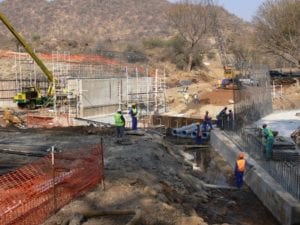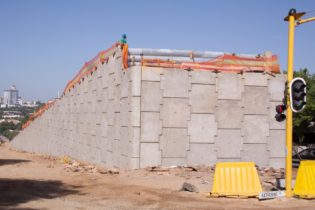By Jaco van Niekerk, Department of Water Affairs: Construction
The construction of the De Hoop Dam is at the heart of the Olifants River Water Resources Development Project (ORWRDP), which is intended to unlock economic potential in the region and improve social development in Limpopo. Several innovations were made in the construction of the dam – and even records broken. The ORWRDP consists on a number of phases. Phase 1 was the raising of Flag Boshielo Dam, which was completed in 2006. Phase 2A is the construction of the new De Hoop Dam that is currently underway in the Limpopo province. Phases 2B to 2H includes bulk water infrastructure consisting of pipelines, reservoirs, pump stations, balancing dams and river gauging structures. From that point onwards, the municipalities would be responsible for further distribution. The then president of South Africa, Thabo Mbeki, announced the construction of a dam in the Olifants River system in his 2003 State of the Nation Address. The stated goal was to unlock the rich mineral deposits in Limpopo and – with such a catalyst – also economically supply water to towns, industries and poorly serviced communities in the Sekhukhune area. The De Hoop Dam was found to be the only feasible option to supply water to the Nebu Plateau where about 800 000 people reside. The Cabinet of the government of South Africa approved the construction of De Hoop Dam in June 2004. Applications for environmental authorisation commenced in 2004 and initial planning and dam type investigation studies also commenced. Design process and concrete innovations Towards the end of 2005, the Department of Water Affairs’ Chief Directorate: Engineering Services commenced with the design process. De Hoop Dam will be one of the biggest dams in South Africa with a total concrete volume of more than 1 million m3 of concrete. Construction of the dam commenced in June 2007 and the project is currently nearing completion. Significant improvements in the roller-compacted concrete (RCC) mix design have been implemented since the beginning of the dam construction. These led to a vast simplification of the construction process and allowed the highest construction rates ever achieved in South Africa with a peak of more than 130 000 m3 of RCC placed in one month. This also resulted in the Department of Water Affairs becoming a world leader in RCC construction technology by effectively developing immersion vibrated roller-compacted concrete (IVRCC ). The first international experience with IVRCC at De Hoop dam has been extremely successful and has been up one of the most significant contributions to the RCC dam construction technology in recent years. A very workable RCC mix could be designed that allowed placement with both roller compaction and with immersion vibration. During the preliminary trials in April 2009, it was proven that the new RCC mix did not require any additional grout at the point of placement and it could be directly consolidated by immersion vibration. IVRCC has been used against the formwork and rock abutment as interface concrete and in the main dam achieving an excellent finish and an extraordinary in-situ quality. Following this first experience, IVRCC has been further implemented in other projects. In addition to the key mix design aspects and specific placement procedures associated with this main topic, this paper provides a general description of the dam construction methodology and quality control. Some of the difficulties encountered throughout the construction period and lessons learned are also discussed. The following is a photograph of the nearly completed De Hoop Dam. Materials and RCC mix optimisation The experience at De Hoop Dam has been extremely useful in developing a new approach to RCC materials and mixes in South Africa. Former RCC dams built in the past by the Department of Water Affairs had followed the low paste approach. RCC mixes were formerly placed at a water to cement ratio of about 0.9. Despite the relatively high water content, these mixes tended to segregate and the concrete was generally of a poorer quality than the traditional conventional concrete. As a result, the design team at De Hoop decided to follow a mix approach with a higher paste content that would also be easier to consolidate by roller compaction. Main properties of the initial RCC mix Crushed coarse and fine aggregate have been used from a quarry production installed in the future reservoir area. In the initial stages of the mix design, the envelopes of the aggregate grading curves were revised and the allowance for the fine content of the sand was increased up to 10% passing 0.075 mm sieve. Coarse aggregate following the SANS standard and with a maximum size of 53 mm was used during the preliminary trials. In the original specified mix, the sand/total aggregate ratio was 41% and the workability was between 15 and 25 seconds. The total cementitious materials content ranged between 180 and 190 kg/m3 with 72% pulverised fly ash. The water to cementitious ratio was 0.62. The investigation of the initial mix at the laboratory and on several test sections concluded that there was still a need for improvement. Although the mix behaved well at the laboratory (in terms of compaction and strength parameters), the cores extracted from the test sections indicated some spots with segregation and in some cases lack of bonding between layers. During placement, the fresh RCC mix did not look as a typical high-pozzolanic workable mix. When placed, there was still some signs of segregation at the bottom of the heap and the mix looked too dry. During compaction it was not possible to get much paste on the surface and there was no movement when walking on top of this concrete. These were all signs of a less workable and drier mix than desired. The replacement of the conventional facing concrete by grout-enriched RCC was also tested in the early trials. Despite the fact that the surface finish was adequate, the vibration effort was high, even when adding a grout that had a water to cement ratio as high as 1.0. Some difficulties were experienced in achieving a good consolidation and bonding with the adjacent roller compacted concrete. Mix design improvements In order to overcome these problems, a more workable mix was suggested during an external review of the construction methodology and the placement procedures. The modifications suggested in the RCC mix design are summarised as follows:- maximum aggregate size of 38 mm (instead of 53 mm)
- slight modification of the overall gradation curve
- fine aggregate 38% of the total aggregate (instead of 41%), Ordinary Portland Cement (OPC)cement 0 kg/m3 (instead of 56 kg/m3)
- fly ash 140 kg/m3 (instead of 130 kg/m3)
- mix consistency between 8 and 10 seconds VeBe. The water content was increased from 114 to 125 ℓ/m3 (water to cementitious ratio kept at similar value as before)
- use of a retarder admixture to achieve initial set of the RCC at around 20 hours, to improve bonding between layers.
|
Concrete mix description |
Original RCC mix (Grade 15/53) |
IVRCC mix (Grade 15/38) |
CVC (Grade 15/38) |
|
Ordinary Portland Cement |
68 kg/m3 |
62 kg/m3 |
87 kg/m3 |
|
Pulverised fly ash |
172 kg/m3 |
145 kg/m3 |
203 kg/m3 |
|
Total cementitious |
240 kg/m3 |
207 kg/m3 |
290 kg/m3 |
|
53. 0 mm course aggregate |
316 kg/m3 |
|
|
|
37.5 mm course aggregate |
505 kg/m3 |
883 kg/m3 |
789 kg/m3 |
|
19 mm Course Aggregate |
631 kg/m3 |
483 kg/m3 |
511 kg/m3 |
|
Sand |
816 kg/m3 |
877 kg/m3 |
821 kg/m3 |
|
Water |
120 ℓ/m3 |
122 ℓ/m3 |
145 ℓ/m3 |
|
Additive (Superplasticizer) |
– |
– |
2 40 cc |
|
Additive (Retarder) |
– |
2 500 cc |
– |
|
W:C Ratio |
0.52 |
0.59 |
0.50 |
The following is a photograph of IVRCC placement in progress:
Main features of the dam
The main features of the dam are as follows:
Table 2: Main features of De Hoop Dam
|
1 |
Gross storage capacity [million m3] |
347,4 |
|
2
|
Catchment area [km2] |
2 865 |
|
3 |
Approximate length [m] |
1 017 |
|
4 |
Approximate height [m] |
88 |
|
5 |
Total excavation – dam footprint [m3] |
415 000 |
|
6 |
Total excavation quarry [m3] |
1 300 000 |
|
7 |
Total estimated concrete volume of the dam [m3] |
1 100 000 |
The First Stage River Diversion consisted of earth-fill embankments (diversion channel) constructed towards the left of the outlet works and spillway, allowing for construction activities to commence in the position of the outlet works and a section of the spillway.
The Second Stage River Diversion consisted of a diversion culvert constructed immediately next to the outlet works and allowing for construction activities to commence towards the spillway and left bank vicinity.
The Second Stage River Diversion will remain in position until commencement of impoundment. This implies that operation of the dam will commence although construction of the dam is not entirely complete.
The use of the outlet system for river diversion would be very limited. Only once the second stage diversion culvert has been closed can the outlet pipes be used to divert the river flow through to the downstream section while the construction of the main dam wall is being completed.
Site layout and installations
Batching plans consisting of a 4.5 m3 Liebherr unit, a 2.5 m3 Icon unit, a double drum SGME, a single drum SGME as well as a 2.5 m3 Liebherr unit are used for concrete production. s Articulated dump trucks as well as a conveyor system are used to transport concrete from the batching plant up to the point of placement.
Concrete placement record achievements
Further to this achievement, the contractor attempted to break the South African record for the volume of concrete placed in a month during November 2010. The previous record of 40 600 m3 of concrete placed in a month was bettered during this attempt, with a total concrete volume of 103 000 m3 being placed in 21 days.
A further attempt to break this record was conducted during November 2011 and proved to be extremely successful. A total concrete volume of 131 000 m3 was placed in 28 days. Concrete placement of this magnitude was never attempted in the past and it is believed that this record will stand for the foreseen future.
Conclusion
Progress currently stands at approximately 90%. Construction of the dam provided employment opportunities for in excess of 1 100 employees, of which 80% were local labour.
Numerous challenges were experienced in the construction process. Some of these challenges included: deeper excavation requirement due to geological reasons, concrete mix development in order to ensure international best practice as well as procurement of construction materials and establishment of a quarry, sufficient in size, to provide for the vast amount of required aggregate.
The De Hoop Dam Project is truly a flagship project for the Department of Waters Affairs of South Africa and possibly one of the largest projects for the foreseeable future. Water needs in the Limpopo Province will be addressed and poverty will be greatly reduced. Lessons learned and technological innovations will change how future projects will be addressed.
|
Concrete mix description |
Original RCC mix (Grade 15/53) |
IVRCC mix (Grade 15/38) |
CVC (Grade 15/38) |
|
Ordinary Portland Cement |
68 kg/m3 |
62 kg/m3 |
87 kg/m3 |
|
Pulverised fly ash |
172 kg/m3 |
145 kg/m3 |
203 kg/m3 |
|
Total cementitious |
240 kg/m3 |
207 kg/m3 |
290 kg/m3 |
|
53. 0 mm course aggregate |
316 kg/m3 |
|
|
|
37.5 mm course aggregate |
505 kg/m3 |
883 kg/m3 |
789 kg/m3 |
|
19 mm Course Aggregate |
631 kg/m3 |
483 kg/m3 |
511 kg/m3 |
|
Sand |
816 kg/m3 |
877 kg/m3 |
821 kg/m3 |
|
Water |
120 ℓ/m3 |
122 ℓ/m3 |
145 ℓ/m3 |
|
Additive (Superplasticizer) |
– |
– |
2 40 cc |
|
Additive (Retarder) |
– |
2 500 cc |
– |
|
W:C Ratio |
0.52 |
0.59 |
0.50 |








